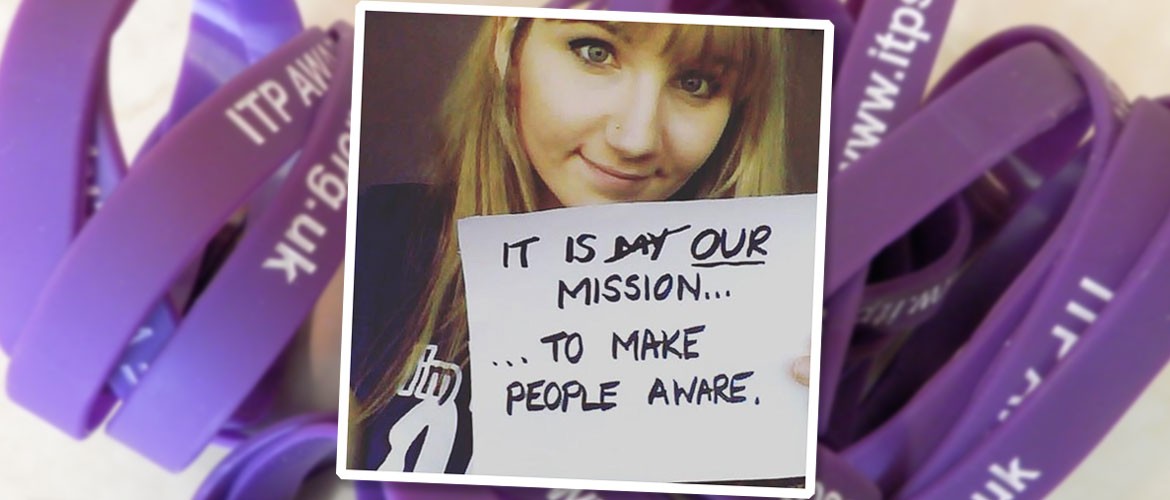‘I had hallucinations, I put on eight pounds in eight days, I wasn’t able to sleep. I felt like I was going crazy.’
It might sound like Katie Meloy is describing the symptoms of her rare blood disorder, but she’s actually detailing the hellish steroid treatment she had to endure to bring it under control.
The 21-year-old York fish and chip shop manager suffers from Idiopathic Thrombocytopenic Purpura (ITP) and, if you haven’t heard of it, you’re not alone.
Most people are completely unaware of its existence but, for the 90,000 people suffering from chronic ITP in Europe and the US, this rare blood and auto-immune disorder has serious, potentially fatal consequences.

If you have ITP, your antibodies attack your healthy platelets – the parts of the blood that help the blood clot. The lack of platelets that can lead to serious bleeding.
There is currently no cure. And treatment, which includes steroids and chemotherapy drugs, can have severe and dangerous side-effects.
Lips covered in blisters
Katie, manager of The Blue Fin fish and chip shop in Tadcaster Road, was diagnosed with the condition in January 2014.
So when did she first realise that something was wrong?
The next morning, however, I had blue lips with blood blisters over them. I’d also come out in big bruises over my legs and felt really tired. That’s when I was admitted to hospital.

Katie’s platelet count was so low doctors at first questioned whether she might be pregnant – or have HIV.
When they eventually told her it was ITP, she had no idea what it meant, or what the consequences might be. She explains what happened next:
I felt like I shouldn’t be there as I was around all these really ill people with drips and emergency buttons. It was then that it sunk in that there must be something wrong for me to be there.
Doctors put her on steroids resulting in hallucinations, weight gain and insomnia. It was horrific but it started to work and her platelet count increased to eight, which meant she was allowed home.
At serious risk
Two days later her count was 30 but, within a week, it had plummeted back to zero, putting her at risk of serious bleeds.
Doctors then had no choice but to try the chemotherapy drug, Rituximab, which can take between five and 12 weeks to start working.
Katie started to get blood blisters on the inside of her mouth and nose bleeds.
Her doctors were concerned she would have a bad bleed and admitted her to hospital for emergency IVIG (intravenous immunoglobulin) to boost her platelets.

“It was Valentine’s Day and my boyfriend came to see me in hospital because we’d originally planned to go out for a meal and I was really annoyed that I’d been admitted.
“We were watching a film together when I started to have a really bad reaction to the treatment; maybe a bleed on the brain or chemical meningitis. The doctors were worried that I was going to slip into a coma.”
Katie began vomiting and developed an unbearable headache. Fortunately, as soon as she stopped the IVIG treatment, she started to get better.
Lucky to be alive
“Looking back, I can’t believe how lucky I was as a bleed in the brain or chemical meningitis are the reasons ITP can be fatal,” said Katie.
Happily she began responding positively to treatment and her platelet count shot up to 416. She now has a stable count of about 200 and hasn’t had any more bleeds.
That doesn’t mean, however, that her problems with ITP are over…

There’s an 80% chance she could relapse in the next 18 months. After that, the chance drops a little but will never completely disappear.
“Unfortunately, the body builds up a resistance to the treatments and they can stop working altogether.”
Positive changes
But, perhaps surprisingly, having ITP has also had a positive effect on Katie’s life.
She now blogs about her experiences in a bid to raise awareness at Me, Myself & ITP.
“It’s actually opened a lot of doors for me and given me the opportunity to meet a lot of new people.
“I’m hoping to go to an ITP convention in America and I’ve also found that I’m very passionate about raising awareness of the condition.”
Katie recently completed a Sea-to-Sea fundraiser as part of ITP Awareness Month in September. This involved a 140-mile static bike ride – the distance between the east and west coasts – outside The Blue Fin.
She’s also created an awareness-raising video with contributions from ITP sufferers around the world.
With an increase in understanding and, hopefully, funding for more research, Katie hopes there will one day be less dangerous treatments and, perhaps, a cure.
And this remarkable young woman is playing a crucial part in making that happen.
